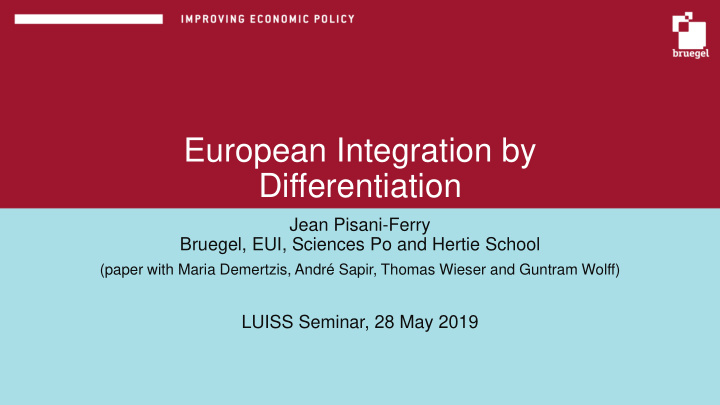



European Integration by Differentiation Jean Pisani-Ferry Bruegel, EUI, Sciences Po and Hertie School (paper with Maria Demertzis, André Sapir, Thomas Wieser and Guntram Wolff) LUISS Seminar, 28 May 2019
Times are changing New issues • Mass migration and asylum • Climate change • Cybersecurity • Economic sovereignty New behaviours • « Sovereignty » • US / China New divides • Brexit • East/West • North/South 2
The issue EU must redefine European public goods • Internal integration has run out of steam (though much to be done..) • Increasing doubts regarding « ever-closer union » • External dimension has gained relevance (economic sovereignty, defence, migrations, climate) • In an hostile climate (2011-2012: surrounded by friends. Not anymore) But no consensus • Same isolationist forces that undermine the multilateral order undermine the EU • Long-standing differences in preferences: defence • Serious, though probably temporary disagreements: climate • New, deep cultural divide: identity and migrations Serious risks for the EU • New mission, but inability to respond > loss of relevance and legitimacy • Neglect of differences > internal division 3
A related issue EU must redefine relationship with its neighbours • UK: what framework post 31/10/2019? • Balkans: enlargement delayed at best • Ukraine, Turkey: in search of a model Vital in an increasingly challenging environment • US, China reactivating or building clientèles • Risk of neighbours drifting away But « hub-and-spokes » EEA framework ill-suited • Too asymmetric (partners are only rule-takers) • Too rigid 4
The legacy EU designed as single undertaking • Strong underlying mechanisms ( acquis ) : indivisibility + irreversibility Two alternative ways to reconcile differences • Multi-speed - eg for the euro. Same goal, different pace • QMV - has worked well for implementation of single market Difficult challenges ahead • Euro: multi-speed increasingly fictional: • Refugees: QMV has failed politically (Council decision not implemented despite ECJ ruling) • Foreign and security policies: different preferences (Russia, China, US) • Investment control • Growing risk of stalemate Need to rethink the integration model 5
The agenda Break the taboos • Is the acquis divisible? YES • Can some countries move backward? YES, accommodate changes in preferences Define the complementarities • No to cherry-picking • But there can be different levels and different fields of integration • Essential that complementarities are preserved Choose an integration models • Concentric circles : Institutionally simple, functionally disputable • Why link euro and defence? • Separate circles : functionally operational, institutionally unworkable • Lack of institutional unity • Endogenous divergence, negative spillovers 6
The proposal Common base for all: a "bare-bones EU" built around single market and CU • Fundamental principles (cos EU is not just an economic entitity • Rule of law & democracy • Fundamental rights of persons, citizens and workers • Customs union • Common trade policy • Single-market related policies: • Four freedoms • Competition, consumer protection • Services regulations • Related sectoral policies: transportation, TEN • Structural funds + Clubs 7
What clubs? Limited number of policy-coherent clubs designed to internalise externalities Euro club • Money • Banking • Budget Migration + Schengen • Common asylum policy • Common refugees protection agency • Common border control Security and defence • Procurement • Infrastructure • Intervention Climate club? Hopefully not, but may be needed Taxation club (for CIT)? Arguably not, but may be needed if EU is deadlocked 8
Institutional structure NOT a concentric circles model (no hierarchy) Legal and institutional system for common base (Treaty/Commission/Council/ECJ/Parliament) Legal base eventually stripped out of non-essentials (« ever closer union » and aspirations) Clubs involve: • Specific treaties • Specific secretariats, either anchored in the Commission or separated (à la ESM) • Parliament formations corresponding to club geometry (when needed) Clubs may include outside guests (e.g. UK for defence) 9
Joining and leaving clubs Club structure should ensure: • Coherence (externalities across policy areas) • Fair degree of homogeneity • Fair degree of stability Significant problems involved (Alesina-Angeloni-Etro 2005, Nordhaus 2015) Hence: • Explicit criteria for joining (not new) • Entry by self-selection + decision by existing members • Exit possible in principle, high hurdles may be needed to avoid instability (eg national constitution) 10
A wider partnership Proposed structure by itself not a solution to UK / Turkey / Balkans problems But differentiated integration philosophy would help find solutions to them Possibility of « EU minus » involving: • Customs union • Some single market elements • No labour mobility • Less strict conditions for rights and values Would lead to multilateralisation of current partnerships 11
Likely consequences Different choices, different fates • Some EU countries would choose not to go beyond bare-bones EU • Some would join all clubs • Some EEA members would join bare-bones EU • Some would prefer EU-minus • What if some EU members prefer to go for EU minus? Not a tragedy 12
Agenda 1. Testing demand: Informal « coalitions of the willing » 2. Geometry of clubs (eg. Asylum + Schengen) 3. Institutional structure 4. Redefinition of EU essentials (what in the acquis is truly indivisible) 5. Content and structure of EU-minus 13
Recommend
More recommend